The Role of Leadership Style in Employee Turnover: A Literature Review
VerifiedAdded on 2022/12/29
|19
|4659
|89
Report
AI Summary
This report presents a comprehensive literature review exploring the impact of leadership styles on employee turnover. It examines the relationship between transformational and transactional leadership approaches and employee retention, drawing on a wide range of scholarly articles and research studies. The review delves into the conceptualization of turnover intention, the direct and indirect costs associated with employee turnover, and the influence of various leadership styles on employee behavior and organizational outcomes. The report analyzes the key themes, integrates ideas, and critiques research findings, highlighting controversies and discrepancies. It also provides a critical evaluation of the relevance of the literature to the research topic, offering valuable insights into the role of leadership in shaping employee turnover rates and organizational success. The report concludes with a synthesis of the findings and implications for future research and practice. This assignment is contributed by a student and is available on Desklib, a platform providing AI-based study tools for students.
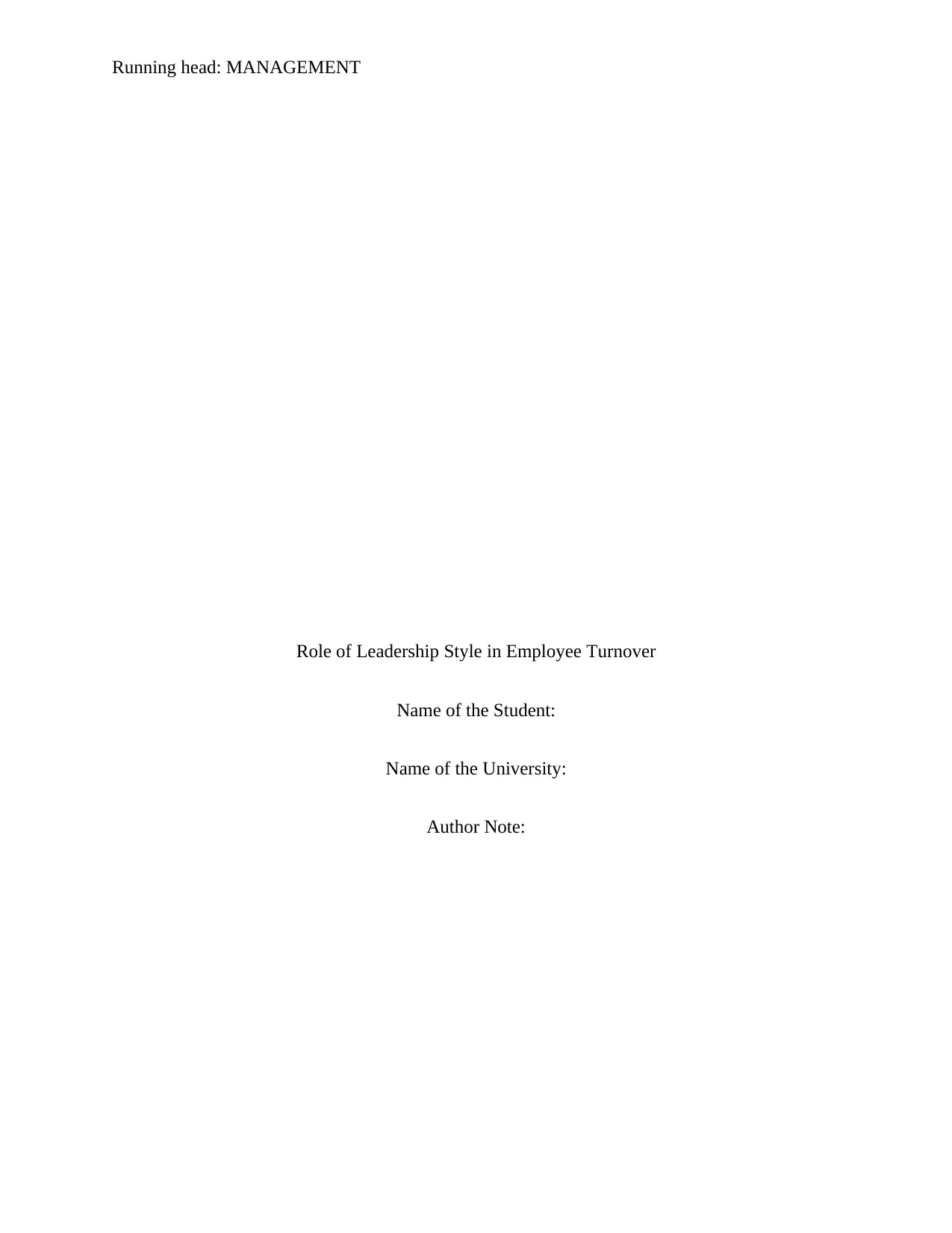
Running head: MANAGEMENT
Role of Leadership Style in Employee Turnover
Name of the Student:
Name of the University:
Author Note:
Role of Leadership Style in Employee Turnover
Name of the Student:
Name of the University:
Author Note:
Paraphrase This Document
Need a fresh take? Get an instant paraphrase of this document with our AI Paraphraser
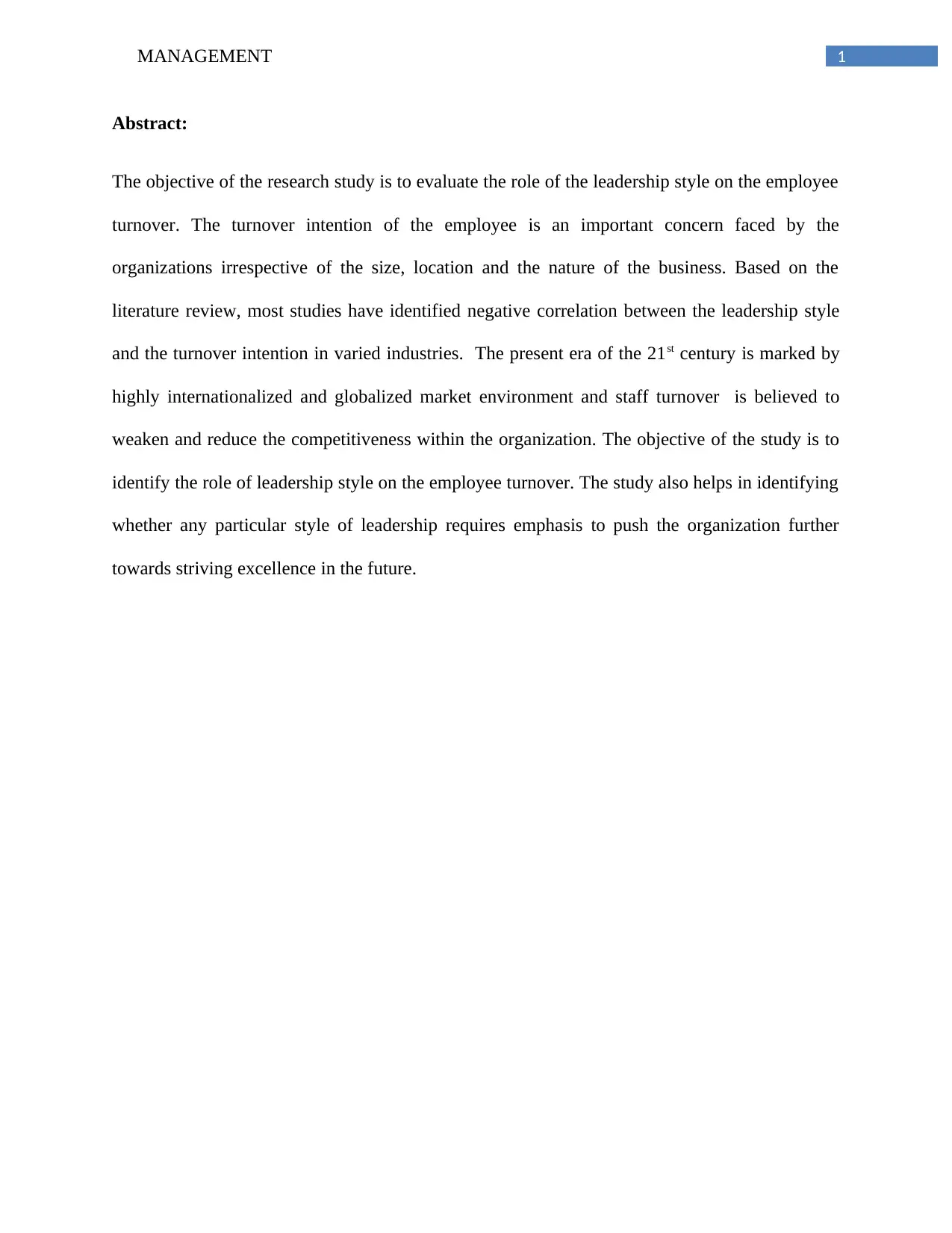
1MANAGEMENT
Abstract:
The objective of the research study is to evaluate the role of the leadership style on the employee
turnover. The turnover intention of the employee is an important concern faced by the
organizations irrespective of the size, location and the nature of the business. Based on the
literature review, most studies have identified negative correlation between the leadership style
and the turnover intention in varied industries. The present era of the 21st century is marked by
highly internationalized and globalized market environment and staff turnover is believed to
weaken and reduce the competitiveness within the organization. The objective of the study is to
identify the role of leadership style on the employee turnover. The study also helps in identifying
whether any particular style of leadership requires emphasis to push the organization further
towards striving excellence in the future.
Abstract:
The objective of the research study is to evaluate the role of the leadership style on the employee
turnover. The turnover intention of the employee is an important concern faced by the
organizations irrespective of the size, location and the nature of the business. Based on the
literature review, most studies have identified negative correlation between the leadership style
and the turnover intention in varied industries. The present era of the 21st century is marked by
highly internationalized and globalized market environment and staff turnover is believed to
weaken and reduce the competitiveness within the organization. The objective of the study is to
identify the role of leadership style on the employee turnover. The study also helps in identifying
whether any particular style of leadership requires emphasis to push the organization further
towards striving excellence in the future.
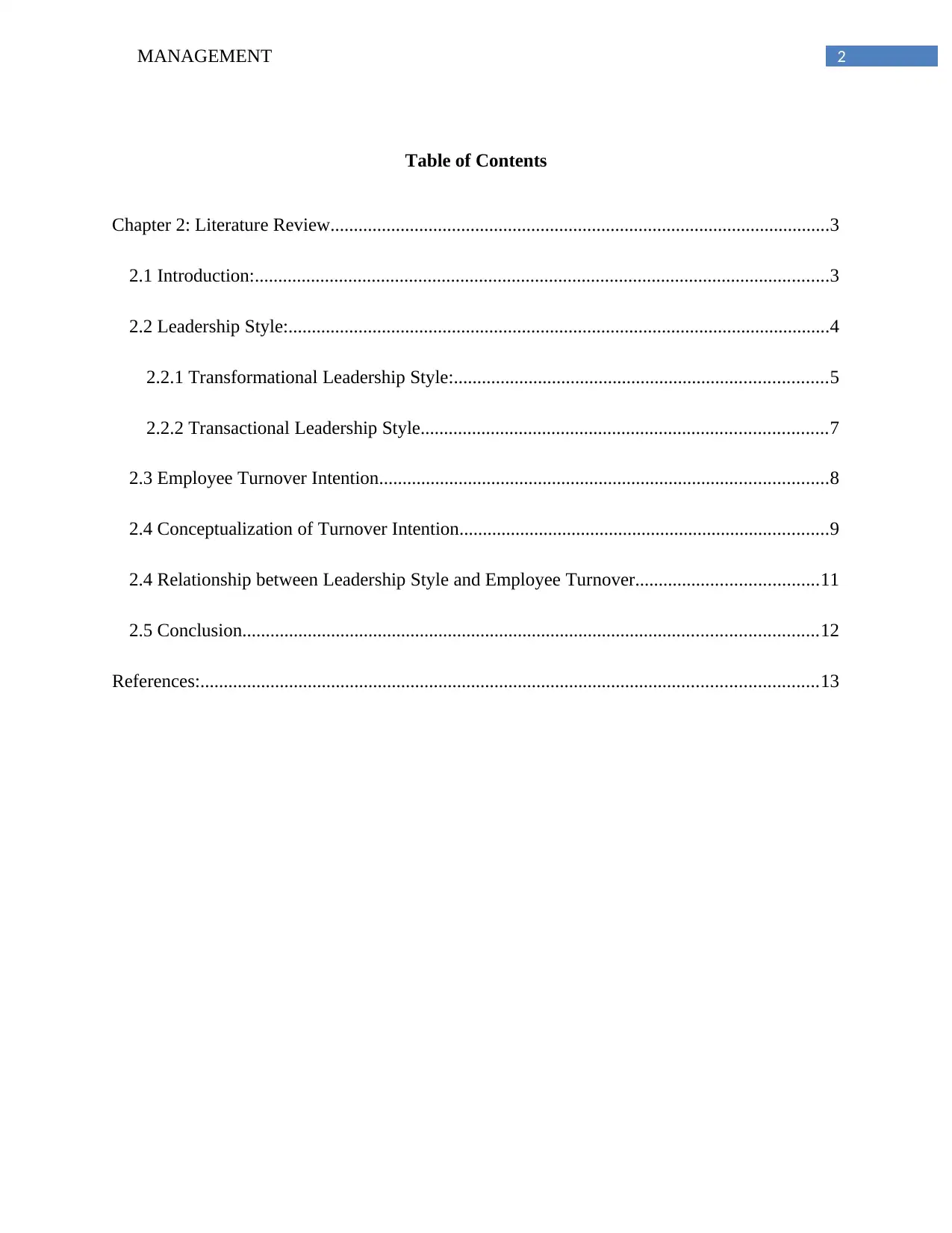
2MANAGEMENT
Table of Contents
Chapter 2: Literature Review...........................................................................................................3
2.1 Introduction:...........................................................................................................................3
2.2 Leadership Style:....................................................................................................................4
2.2.1 Transformational Leadership Style:................................................................................5
2.2.2 Transactional Leadership Style.......................................................................................7
2.3 Employee Turnover Intention................................................................................................8
2.4 Conceptualization of Turnover Intention...............................................................................9
2.4 Relationship between Leadership Style and Employee Turnover.......................................11
2.5 Conclusion...........................................................................................................................12
References:....................................................................................................................................13
Table of Contents
Chapter 2: Literature Review...........................................................................................................3
2.1 Introduction:...........................................................................................................................3
2.2 Leadership Style:....................................................................................................................4
2.2.1 Transformational Leadership Style:................................................................................5
2.2.2 Transactional Leadership Style.......................................................................................7
2.3 Employee Turnover Intention................................................................................................8
2.4 Conceptualization of Turnover Intention...............................................................................9
2.4 Relationship between Leadership Style and Employee Turnover.......................................11
2.5 Conclusion...........................................................................................................................12
References:....................................................................................................................................13
⊘ This is a preview!⊘
Do you want full access?
Subscribe today to unlock all pages.

Trusted by 1+ million students worldwide
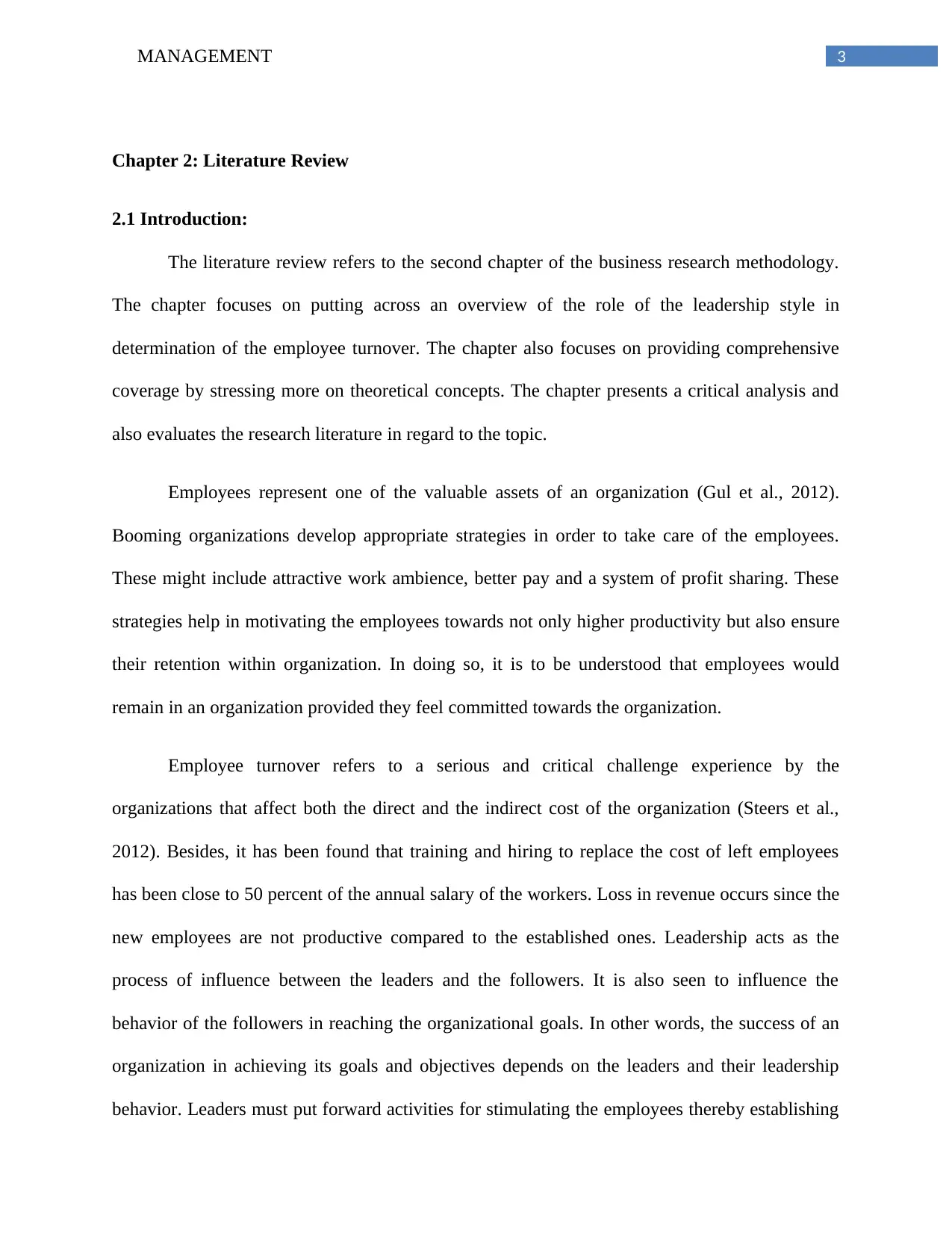
3MANAGEMENT
Chapter 2: Literature Review
2.1 Introduction:
The literature review refers to the second chapter of the business research methodology.
The chapter focuses on putting across an overview of the role of the leadership style in
determination of the employee turnover. The chapter also focuses on providing comprehensive
coverage by stressing more on theoretical concepts. The chapter presents a critical analysis and
also evaluates the research literature in regard to the topic.
Employees represent one of the valuable assets of an organization (Gul et al., 2012).
Booming organizations develop appropriate strategies in order to take care of the employees.
These might include attractive work ambience, better pay and a system of profit sharing. These
strategies help in motivating the employees towards not only higher productivity but also ensure
their retention within organization. In doing so, it is to be understood that employees would
remain in an organization provided they feel committed towards the organization.
Employee turnover refers to a serious and critical challenge experience by the
organizations that affect both the direct and the indirect cost of the organization (Steers et al.,
2012). Besides, it has been found that training and hiring to replace the cost of left employees
has been close to 50 percent of the annual salary of the workers. Loss in revenue occurs since the
new employees are not productive compared to the established ones. Leadership acts as the
process of influence between the leaders and the followers. It is also seen to influence the
behavior of the followers in reaching the organizational goals. In other words, the success of an
organization in achieving its goals and objectives depends on the leaders and their leadership
behavior. Leaders must put forward activities for stimulating the employees thereby establishing
Chapter 2: Literature Review
2.1 Introduction:
The literature review refers to the second chapter of the business research methodology.
The chapter focuses on putting across an overview of the role of the leadership style in
determination of the employee turnover. The chapter also focuses on providing comprehensive
coverage by stressing more on theoretical concepts. The chapter presents a critical analysis and
also evaluates the research literature in regard to the topic.
Employees represent one of the valuable assets of an organization (Gul et al., 2012).
Booming organizations develop appropriate strategies in order to take care of the employees.
These might include attractive work ambience, better pay and a system of profit sharing. These
strategies help in motivating the employees towards not only higher productivity but also ensure
their retention within organization. In doing so, it is to be understood that employees would
remain in an organization provided they feel committed towards the organization.
Employee turnover refers to a serious and critical challenge experience by the
organizations that affect both the direct and the indirect cost of the organization (Steers et al.,
2012). Besides, it has been found that training and hiring to replace the cost of left employees
has been close to 50 percent of the annual salary of the workers. Loss in revenue occurs since the
new employees are not productive compared to the established ones. Leadership acts as the
process of influence between the leaders and the followers. It is also seen to influence the
behavior of the followers in reaching the organizational goals. In other words, the success of an
organization in achieving its goals and objectives depends on the leaders and their leadership
behavior. Leaders must put forward activities for stimulating the employees thereby establishing
Paraphrase This Document
Need a fresh take? Get an instant paraphrase of this document with our AI Paraphraser
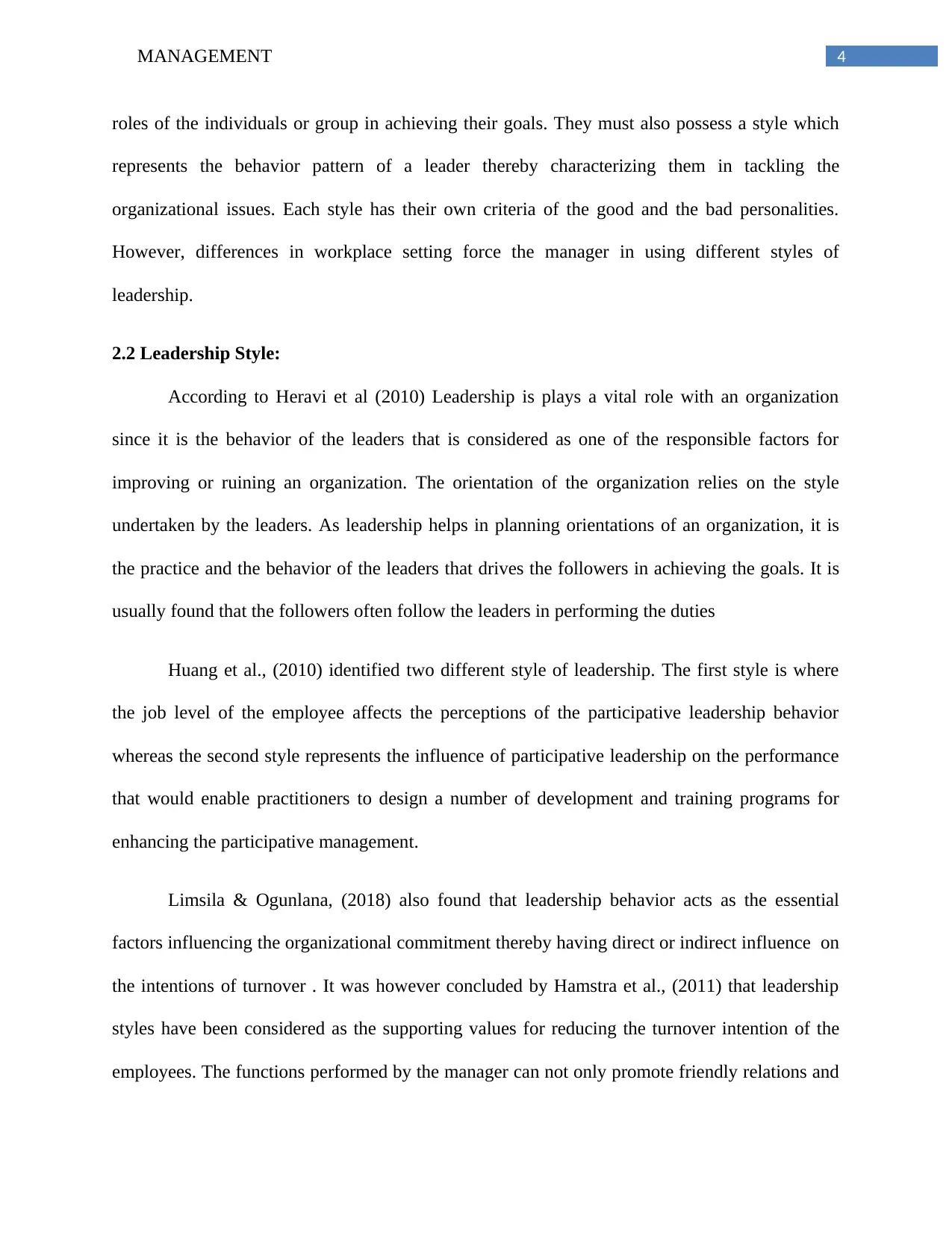
4MANAGEMENT
roles of the individuals or group in achieving their goals. They must also possess a style which
represents the behavior pattern of a leader thereby characterizing them in tackling the
organizational issues. Each style has their own criteria of the good and the bad personalities.
However, differences in workplace setting force the manager in using different styles of
leadership.
2.2 Leadership Style:
According to Heravi et al (2010) Leadership is plays a vital role with an organization
since it is the behavior of the leaders that is considered as one of the responsible factors for
improving or ruining an organization. The orientation of the organization relies on the style
undertaken by the leaders. As leadership helps in planning orientations of an organization, it is
the practice and the behavior of the leaders that drives the followers in achieving the goals. It is
usually found that the followers often follow the leaders in performing the duties
Huang et al., (2010) identified two different style of leadership. The first style is where
the job level of the employee affects the perceptions of the participative leadership behavior
whereas the second style represents the influence of participative leadership on the performance
that would enable practitioners to design a number of development and training programs for
enhancing the participative management.
Limsila & Ogunlana, (2018) also found that leadership behavior acts as the essential
factors influencing the organizational commitment thereby having direct or indirect influence on
the intentions of turnover . It was however concluded by Hamstra et al., (2011) that leadership
styles have been considered as the supporting values for reducing the turnover intention of the
employees. The functions performed by the manager can not only promote friendly relations and
roles of the individuals or group in achieving their goals. They must also possess a style which
represents the behavior pattern of a leader thereby characterizing them in tackling the
organizational issues. Each style has their own criteria of the good and the bad personalities.
However, differences in workplace setting force the manager in using different styles of
leadership.
2.2 Leadership Style:
According to Heravi et al (2010) Leadership is plays a vital role with an organization
since it is the behavior of the leaders that is considered as one of the responsible factors for
improving or ruining an organization. The orientation of the organization relies on the style
undertaken by the leaders. As leadership helps in planning orientations of an organization, it is
the practice and the behavior of the leaders that drives the followers in achieving the goals. It is
usually found that the followers often follow the leaders in performing the duties
Huang et al., (2010) identified two different style of leadership. The first style is where
the job level of the employee affects the perceptions of the participative leadership behavior
whereas the second style represents the influence of participative leadership on the performance
that would enable practitioners to design a number of development and training programs for
enhancing the participative management.
Limsila & Ogunlana, (2018) also found that leadership behavior acts as the essential
factors influencing the organizational commitment thereby having direct or indirect influence on
the intentions of turnover . It was however concluded by Hamstra et al., (2011) that leadership
styles have been considered as the supporting values for reducing the turnover intention of the
employees. The functions performed by the manager can not only promote friendly relations and
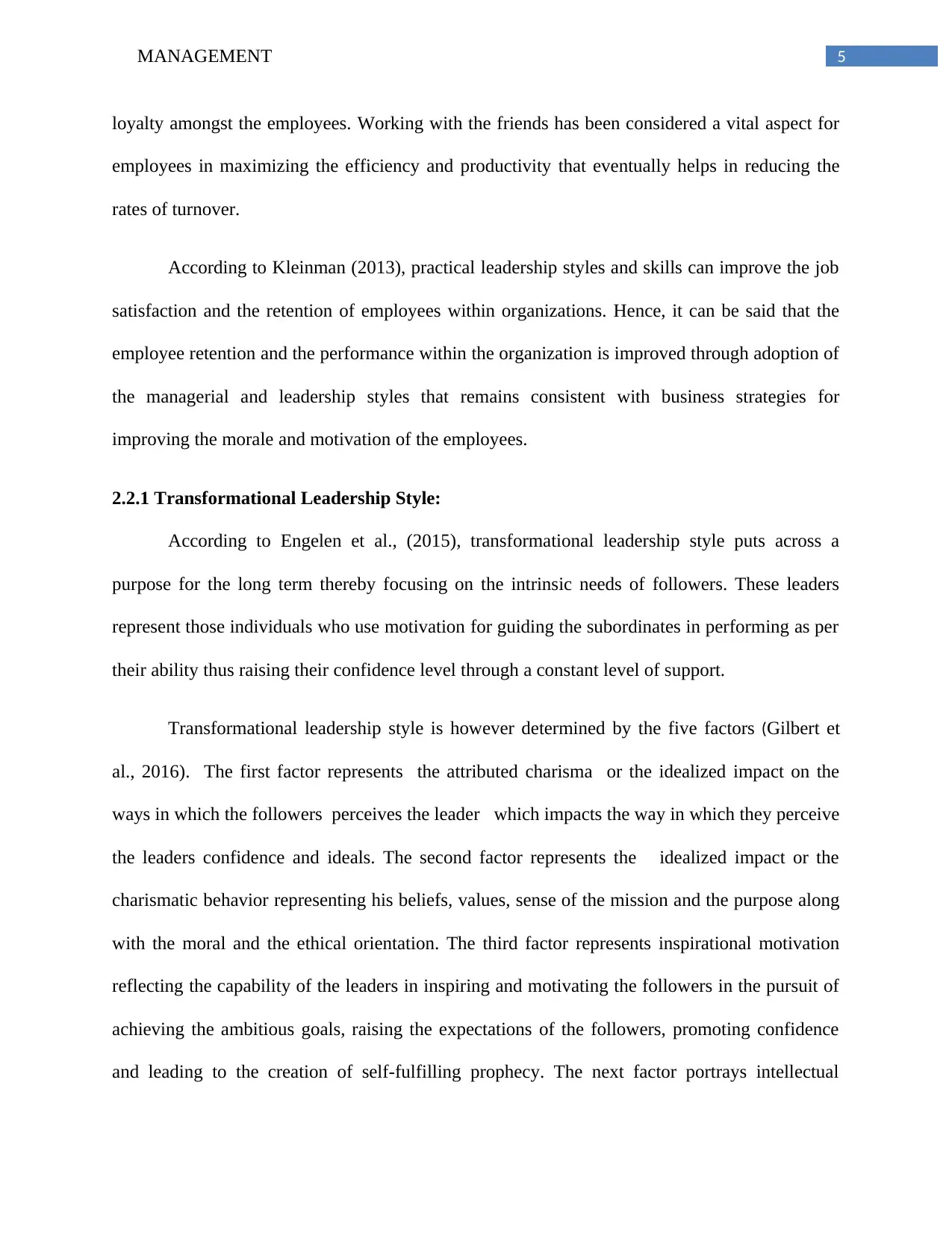
5MANAGEMENT
loyalty amongst the employees. Working with the friends has been considered a vital aspect for
employees in maximizing the efficiency and productivity that eventually helps in reducing the
rates of turnover.
According to Kleinman (2013), practical leadership styles and skills can improve the job
satisfaction and the retention of employees within organizations. Hence, it can be said that the
employee retention and the performance within the organization is improved through adoption of
the managerial and leadership styles that remains consistent with business strategies for
improving the morale and motivation of the employees.
2.2.1 Transformational Leadership Style:
According to Engelen et al., (2015), transformational leadership style puts across a
purpose for the long term thereby focusing on the intrinsic needs of followers. These leaders
represent those individuals who use motivation for guiding the subordinates in performing as per
their ability thus raising their confidence level through a constant level of support.
Transformational leadership style is however determined by the five factors (Gilbert et
al., 2016). The first factor represents the attributed charisma or the idealized impact on the
ways in which the followers perceives the leader which impacts the way in which they perceive
the leaders confidence and ideals. The second factor represents the idealized impact or the
charismatic behavior representing his beliefs, values, sense of the mission and the purpose along
with the moral and the ethical orientation. The third factor represents inspirational motivation
reflecting the capability of the leaders in inspiring and motivating the followers in the pursuit of
achieving the ambitious goals, raising the expectations of the followers, promoting confidence
and leading to the creation of self-fulfilling prophecy. The next factor portrays intellectual
loyalty amongst the employees. Working with the friends has been considered a vital aspect for
employees in maximizing the efficiency and productivity that eventually helps in reducing the
rates of turnover.
According to Kleinman (2013), practical leadership styles and skills can improve the job
satisfaction and the retention of employees within organizations. Hence, it can be said that the
employee retention and the performance within the organization is improved through adoption of
the managerial and leadership styles that remains consistent with business strategies for
improving the morale and motivation of the employees.
2.2.1 Transformational Leadership Style:
According to Engelen et al., (2015), transformational leadership style puts across a
purpose for the long term thereby focusing on the intrinsic needs of followers. These leaders
represent those individuals who use motivation for guiding the subordinates in performing as per
their ability thus raising their confidence level through a constant level of support.
Transformational leadership style is however determined by the five factors (Gilbert et
al., 2016). The first factor represents the attributed charisma or the idealized impact on the
ways in which the followers perceives the leader which impacts the way in which they perceive
the leaders confidence and ideals. The second factor represents the idealized impact or the
charismatic behavior representing his beliefs, values, sense of the mission and the purpose along
with the moral and the ethical orientation. The third factor represents inspirational motivation
reflecting the capability of the leaders in inspiring and motivating the followers in the pursuit of
achieving the ambitious goals, raising the expectations of the followers, promoting confidence
and leading to the creation of self-fulfilling prophecy. The next factor portrays intellectual
⊘ This is a preview!⊘
Do you want full access?
Subscribe today to unlock all pages.

Trusted by 1+ million students worldwide
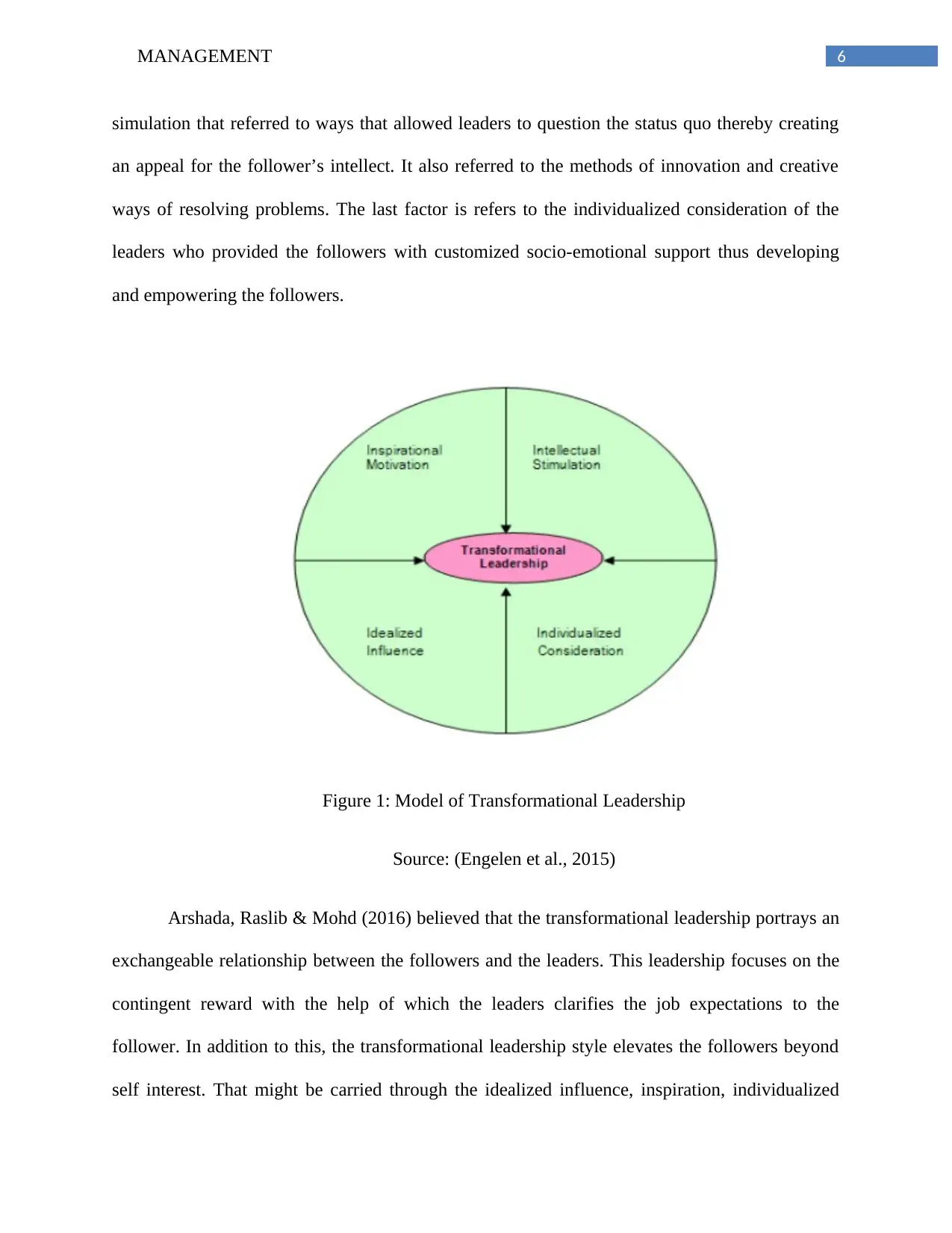
6MANAGEMENT
simulation that referred to ways that allowed leaders to question the status quo thereby creating
an appeal for the follower’s intellect. It also referred to the methods of innovation and creative
ways of resolving problems. The last factor is refers to the individualized consideration of the
leaders who provided the followers with customized socio-emotional support thus developing
and empowering the followers.
Figure 1: Model of Transformational Leadership
Source: (Engelen et al., 2015)
Arshada, Raslib & Mohd (2016) believed that the transformational leadership portrays an
exchangeable relationship between the followers and the leaders. This leadership focuses on the
contingent reward with the help of which the leaders clarifies the job expectations to the
follower. In addition to this, the transformational leadership style elevates the followers beyond
self interest. That might be carried through the idealized influence, inspiration, individualized
simulation that referred to ways that allowed leaders to question the status quo thereby creating
an appeal for the follower’s intellect. It also referred to the methods of innovation and creative
ways of resolving problems. The last factor is refers to the individualized consideration of the
leaders who provided the followers with customized socio-emotional support thus developing
and empowering the followers.
Figure 1: Model of Transformational Leadership
Source: (Engelen et al., 2015)
Arshada, Raslib & Mohd (2016) believed that the transformational leadership portrays an
exchangeable relationship between the followers and the leaders. This leadership focuses on the
contingent reward with the help of which the leaders clarifies the job expectations to the
follower. In addition to this, the transformational leadership style elevates the followers beyond
self interest. That might be carried through the idealized influence, inspiration, individualized
Paraphrase This Document
Need a fresh take? Get an instant paraphrase of this document with our AI Paraphraser
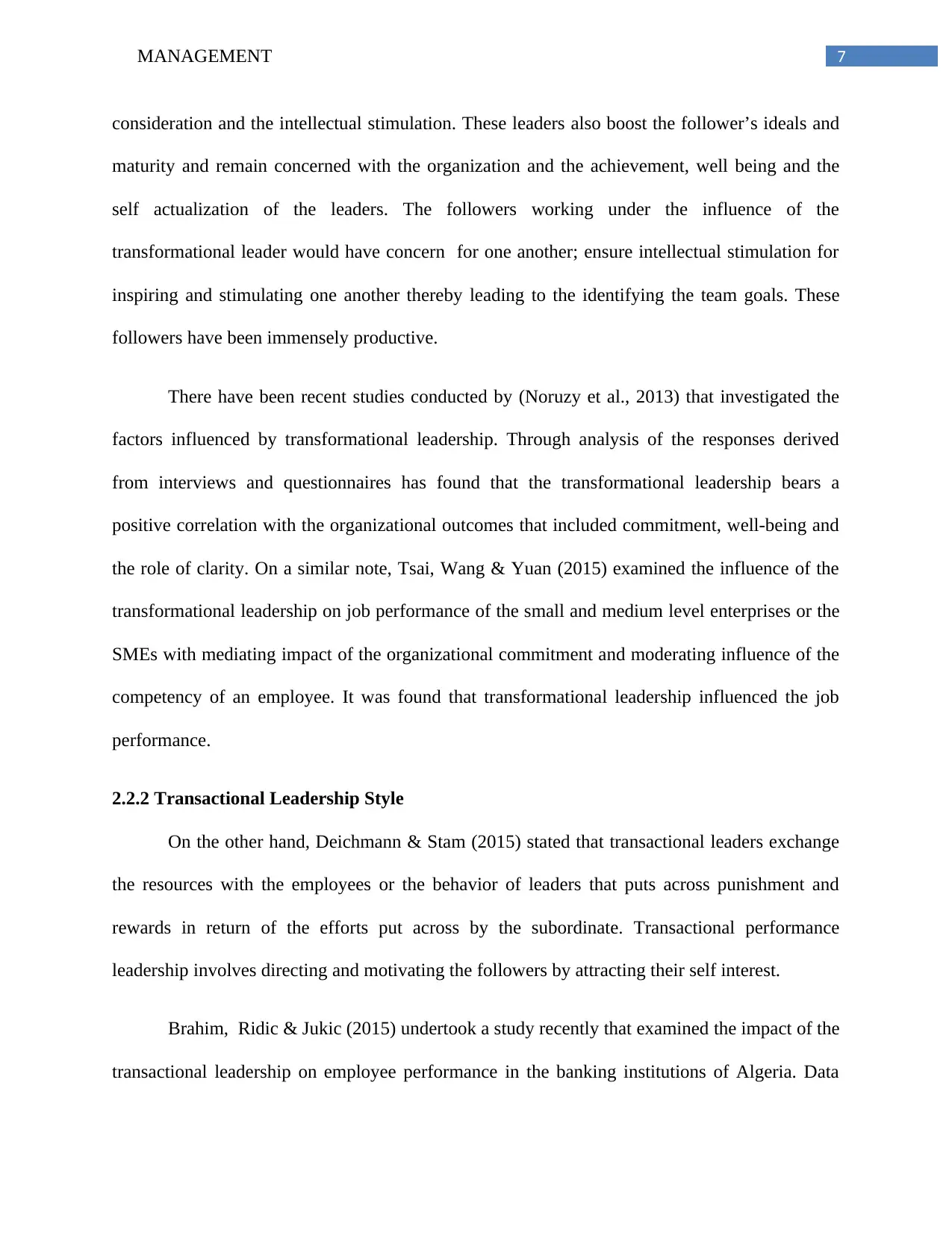
7MANAGEMENT
consideration and the intellectual stimulation. These leaders also boost the follower’s ideals and
maturity and remain concerned with the organization and the achievement, well being and the
self actualization of the leaders. The followers working under the influence of the
transformational leader would have concern for one another; ensure intellectual stimulation for
inspiring and stimulating one another thereby leading to the identifying the team goals. These
followers have been immensely productive.
There have been recent studies conducted by (Noruzy et al., 2013) that investigated the
factors influenced by transformational leadership. Through analysis of the responses derived
from interviews and questionnaires has found that the transformational leadership bears a
positive correlation with the organizational outcomes that included commitment, well-being and
the role of clarity. On a similar note, Tsai, Wang & Yuan (2015) examined the influence of the
transformational leadership on job performance of the small and medium level enterprises or the
SMEs with mediating impact of the organizational commitment and moderating influence of the
competency of an employee. It was found that transformational leadership influenced the job
performance.
2.2.2 Transactional Leadership Style
On the other hand, Deichmann & Stam (2015) stated that transactional leaders exchange
the resources with the employees or the behavior of leaders that puts across punishment and
rewards in return of the efforts put across by the subordinate. Transactional performance
leadership involves directing and motivating the followers by attracting their self interest.
Brahim, Ridic & Jukic (2015) undertook a study recently that examined the impact of the
transactional leadership on employee performance in the banking institutions of Algeria. Data
consideration and the intellectual stimulation. These leaders also boost the follower’s ideals and
maturity and remain concerned with the organization and the achievement, well being and the
self actualization of the leaders. The followers working under the influence of the
transformational leader would have concern for one another; ensure intellectual stimulation for
inspiring and stimulating one another thereby leading to the identifying the team goals. These
followers have been immensely productive.
There have been recent studies conducted by (Noruzy et al., 2013) that investigated the
factors influenced by transformational leadership. Through analysis of the responses derived
from interviews and questionnaires has found that the transformational leadership bears a
positive correlation with the organizational outcomes that included commitment, well-being and
the role of clarity. On a similar note, Tsai, Wang & Yuan (2015) examined the influence of the
transformational leadership on job performance of the small and medium level enterprises or the
SMEs with mediating impact of the organizational commitment and moderating influence of the
competency of an employee. It was found that transformational leadership influenced the job
performance.
2.2.2 Transactional Leadership Style
On the other hand, Deichmann & Stam (2015) stated that transactional leaders exchange
the resources with the employees or the behavior of leaders that puts across punishment and
rewards in return of the efforts put across by the subordinate. Transactional performance
leadership involves directing and motivating the followers by attracting their self interest.
Brahim, Ridic & Jukic (2015) undertook a study recently that examined the impact of the
transactional leadership on employee performance in the banking institutions of Algeria. Data
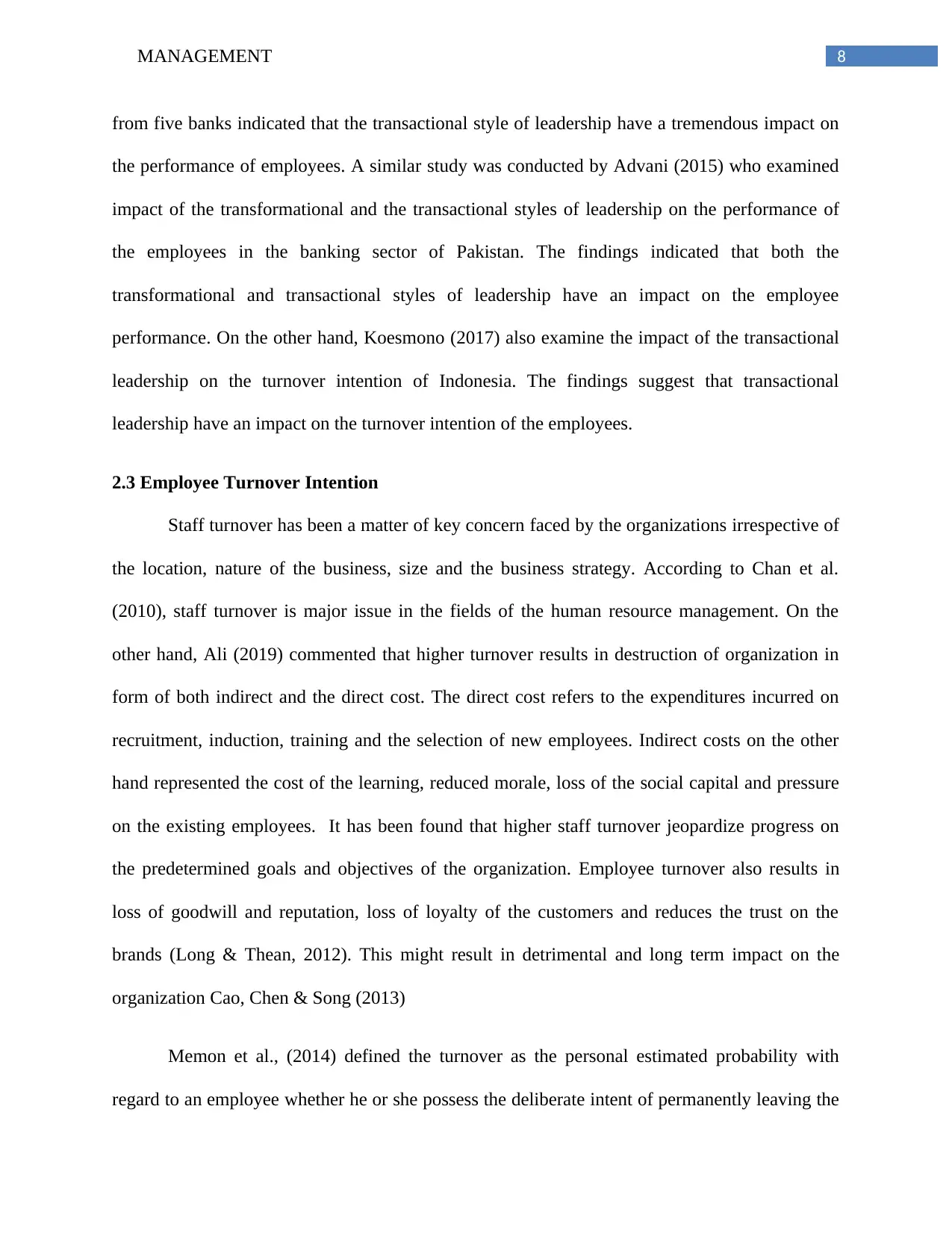
8MANAGEMENT
from five banks indicated that the transactional style of leadership have a tremendous impact on
the performance of employees. A similar study was conducted by Advani (2015) who examined
impact of the transformational and the transactional styles of leadership on the performance of
the employees in the banking sector of Pakistan. The findings indicated that both the
transformational and transactional styles of leadership have an impact on the employee
performance. On the other hand, Koesmono (2017) also examine the impact of the transactional
leadership on the turnover intention of Indonesia. The findings suggest that transactional
leadership have an impact on the turnover intention of the employees.
2.3 Employee Turnover Intention
Staff turnover has been a matter of key concern faced by the organizations irrespective of
the location, nature of the business, size and the business strategy. According to Chan et al.
(2010), staff turnover is major issue in the fields of the human resource management. On the
other hand, Ali (2019) commented that higher turnover results in destruction of organization in
form of both indirect and the direct cost. The direct cost refers to the expenditures incurred on
recruitment, induction, training and the selection of new employees. Indirect costs on the other
hand represented the cost of the learning, reduced morale, loss of the social capital and pressure
on the existing employees. It has been found that higher staff turnover jeopardize progress on
the predetermined goals and objectives of the organization. Employee turnover also results in
loss of goodwill and reputation, loss of loyalty of the customers and reduces the trust on the
brands (Long & Thean, 2012). This might result in detrimental and long term impact on the
organization Cao, Chen & Song (2013)
Memon et al., (2014) defined the turnover as the personal estimated probability with
regard to an employee whether he or she possess the deliberate intent of permanently leaving the
from five banks indicated that the transactional style of leadership have a tremendous impact on
the performance of employees. A similar study was conducted by Advani (2015) who examined
impact of the transformational and the transactional styles of leadership on the performance of
the employees in the banking sector of Pakistan. The findings indicated that both the
transformational and transactional styles of leadership have an impact on the employee
performance. On the other hand, Koesmono (2017) also examine the impact of the transactional
leadership on the turnover intention of Indonesia. The findings suggest that transactional
leadership have an impact on the turnover intention of the employees.
2.3 Employee Turnover Intention
Staff turnover has been a matter of key concern faced by the organizations irrespective of
the location, nature of the business, size and the business strategy. According to Chan et al.
(2010), staff turnover is major issue in the fields of the human resource management. On the
other hand, Ali (2019) commented that higher turnover results in destruction of organization in
form of both indirect and the direct cost. The direct cost refers to the expenditures incurred on
recruitment, induction, training and the selection of new employees. Indirect costs on the other
hand represented the cost of the learning, reduced morale, loss of the social capital and pressure
on the existing employees. It has been found that higher staff turnover jeopardize progress on
the predetermined goals and objectives of the organization. Employee turnover also results in
loss of goodwill and reputation, loss of loyalty of the customers and reduces the trust on the
brands (Long & Thean, 2012). This might result in detrimental and long term impact on the
organization Cao, Chen & Song (2013)
Memon et al., (2014) defined the turnover as the personal estimated probability with
regard to an employee whether he or she possess the deliberate intent of permanently leaving the
⊘ This is a preview!⊘
Do you want full access?
Subscribe today to unlock all pages.

Trusted by 1+ million students worldwide
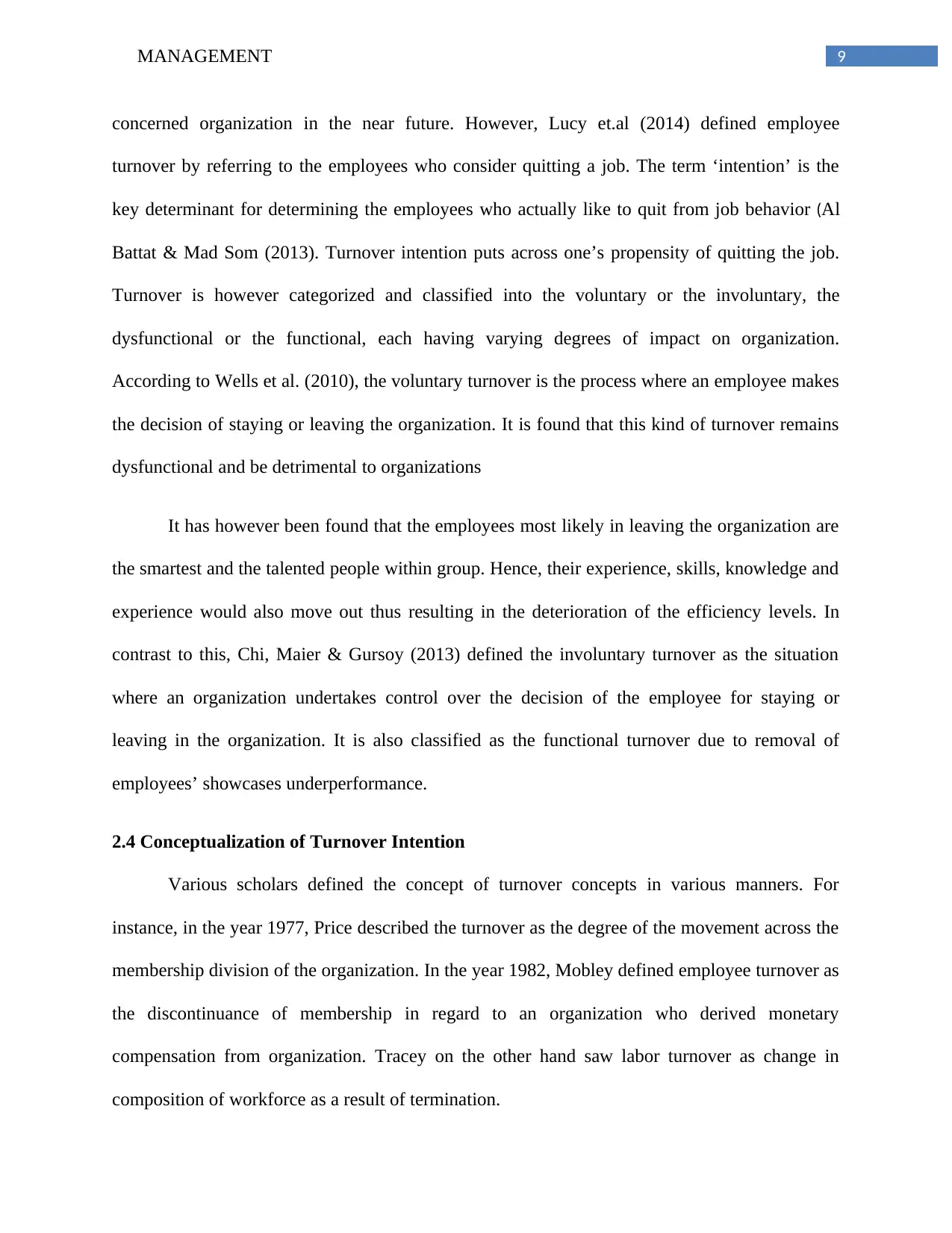
9MANAGEMENT
concerned organization in the near future. However, Lucy et.al (2014) defined employee
turnover by referring to the employees who consider quitting a job. The term ‘intention’ is the
key determinant for determining the employees who actually like to quit from job behavior (Al
Battat & Mad Som (2013). Turnover intention puts across one’s propensity of quitting the job.
Turnover is however categorized and classified into the voluntary or the involuntary, the
dysfunctional or the functional, each having varying degrees of impact on organization.
According to Wells et al. (2010), the voluntary turnover is the process where an employee makes
the decision of staying or leaving the organization. It is found that this kind of turnover remains
dysfunctional and be detrimental to organizations
It has however been found that the employees most likely in leaving the organization are
the smartest and the talented people within group. Hence, their experience, skills, knowledge and
experience would also move out thus resulting in the deterioration of the efficiency levels. In
contrast to this, Chi, Maier & Gursoy (2013) defined the involuntary turnover as the situation
where an organization undertakes control over the decision of the employee for staying or
leaving in the organization. It is also classified as the functional turnover due to removal of
employees’ showcases underperformance.
2.4 Conceptualization of Turnover Intention
Various scholars defined the concept of turnover concepts in various manners. For
instance, in the year 1977, Price described the turnover as the degree of the movement across the
membership division of the organization. In the year 1982, Mobley defined employee turnover as
the discontinuance of membership in regard to an organization who derived monetary
compensation from organization. Tracey on the other hand saw labor turnover as change in
composition of workforce as a result of termination.
concerned organization in the near future. However, Lucy et.al (2014) defined employee
turnover by referring to the employees who consider quitting a job. The term ‘intention’ is the
key determinant for determining the employees who actually like to quit from job behavior (Al
Battat & Mad Som (2013). Turnover intention puts across one’s propensity of quitting the job.
Turnover is however categorized and classified into the voluntary or the involuntary, the
dysfunctional or the functional, each having varying degrees of impact on organization.
According to Wells et al. (2010), the voluntary turnover is the process where an employee makes
the decision of staying or leaving the organization. It is found that this kind of turnover remains
dysfunctional and be detrimental to organizations
It has however been found that the employees most likely in leaving the organization are
the smartest and the talented people within group. Hence, their experience, skills, knowledge and
experience would also move out thus resulting in the deterioration of the efficiency levels. In
contrast to this, Chi, Maier & Gursoy (2013) defined the involuntary turnover as the situation
where an organization undertakes control over the decision of the employee for staying or
leaving in the organization. It is also classified as the functional turnover due to removal of
employees’ showcases underperformance.
2.4 Conceptualization of Turnover Intention
Various scholars defined the concept of turnover concepts in various manners. For
instance, in the year 1977, Price described the turnover as the degree of the movement across the
membership division of the organization. In the year 1982, Mobley defined employee turnover as
the discontinuance of membership in regard to an organization who derived monetary
compensation from organization. Tracey on the other hand saw labor turnover as change in
composition of workforce as a result of termination.
Paraphrase This Document
Need a fresh take? Get an instant paraphrase of this document with our AI Paraphraser
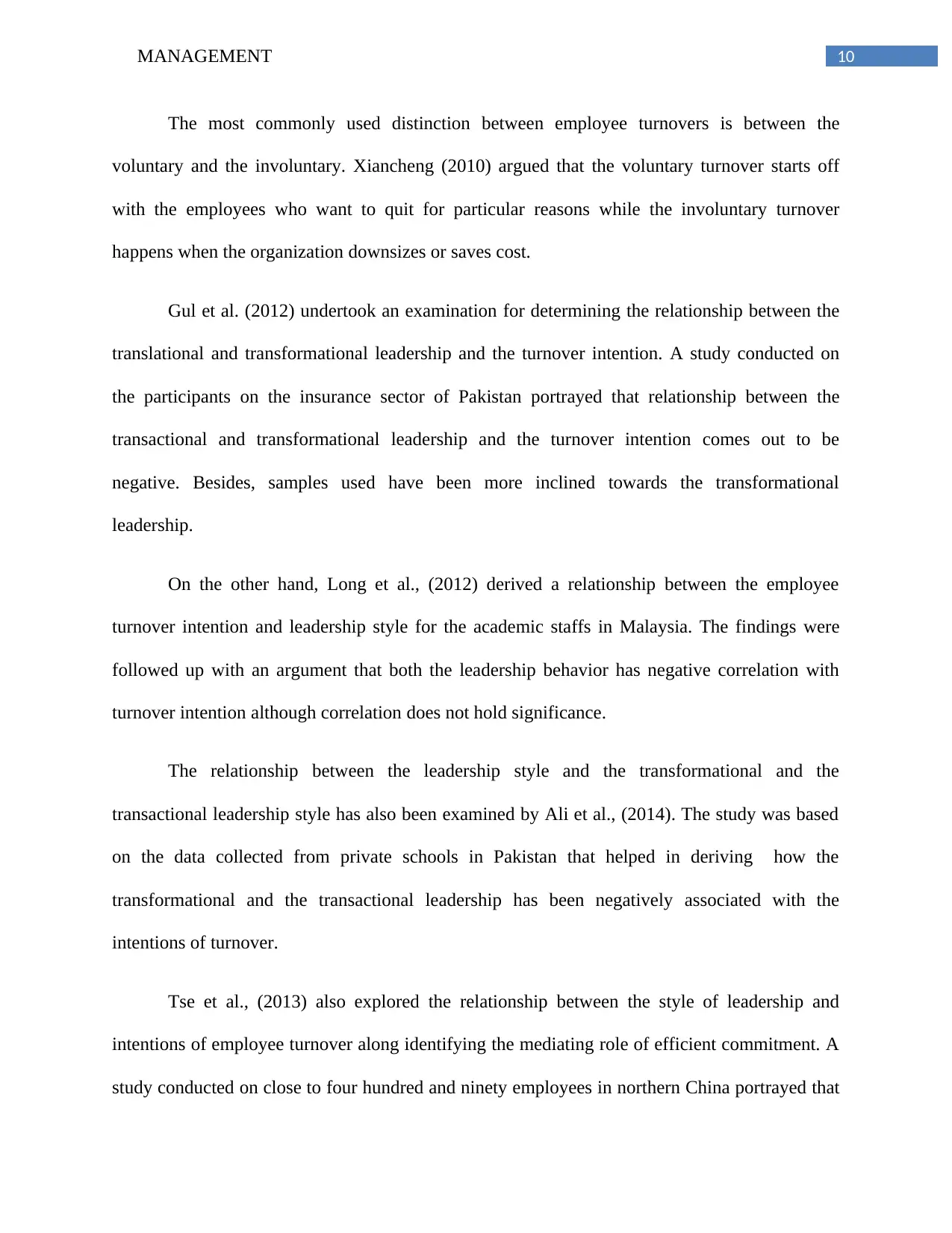
10MANAGEMENT
The most commonly used distinction between employee turnovers is between the
voluntary and the involuntary. Xiancheng (2010) argued that the voluntary turnover starts off
with the employees who want to quit for particular reasons while the involuntary turnover
happens when the organization downsizes or saves cost.
Gul et al. (2012) undertook an examination for determining the relationship between the
translational and transformational leadership and the turnover intention. A study conducted on
the participants on the insurance sector of Pakistan portrayed that relationship between the
transactional and transformational leadership and the turnover intention comes out to be
negative. Besides, samples used have been more inclined towards the transformational
leadership.
On the other hand, Long et al., (2012) derived a relationship between the employee
turnover intention and leadership style for the academic staffs in Malaysia. The findings were
followed up with an argument that both the leadership behavior has negative correlation with
turnover intention although correlation does not hold significance.
The relationship between the leadership style and the transformational and the
transactional leadership style has also been examined by Ali et al., (2014). The study was based
on the data collected from private schools in Pakistan that helped in deriving how the
transformational and the transactional leadership has been negatively associated with the
intentions of turnover.
Tse et al., (2013) also explored the relationship between the style of leadership and
intentions of employee turnover along identifying the mediating role of efficient commitment. A
study conducted on close to four hundred and ninety employees in northern China portrayed that
The most commonly used distinction between employee turnovers is between the
voluntary and the involuntary. Xiancheng (2010) argued that the voluntary turnover starts off
with the employees who want to quit for particular reasons while the involuntary turnover
happens when the organization downsizes or saves cost.
Gul et al. (2012) undertook an examination for determining the relationship between the
translational and transformational leadership and the turnover intention. A study conducted on
the participants on the insurance sector of Pakistan portrayed that relationship between the
transactional and transformational leadership and the turnover intention comes out to be
negative. Besides, samples used have been more inclined towards the transformational
leadership.
On the other hand, Long et al., (2012) derived a relationship between the employee
turnover intention and leadership style for the academic staffs in Malaysia. The findings were
followed up with an argument that both the leadership behavior has negative correlation with
turnover intention although correlation does not hold significance.
The relationship between the leadership style and the transformational and the
transactional leadership style has also been examined by Ali et al., (2014). The study was based
on the data collected from private schools in Pakistan that helped in deriving how the
transformational and the transactional leadership has been negatively associated with the
intentions of turnover.
Tse et al., (2013) also explored the relationship between the style of leadership and
intentions of employee turnover along identifying the mediating role of efficient commitment. A
study conducted on close to four hundred and ninety employees in northern China portrayed that
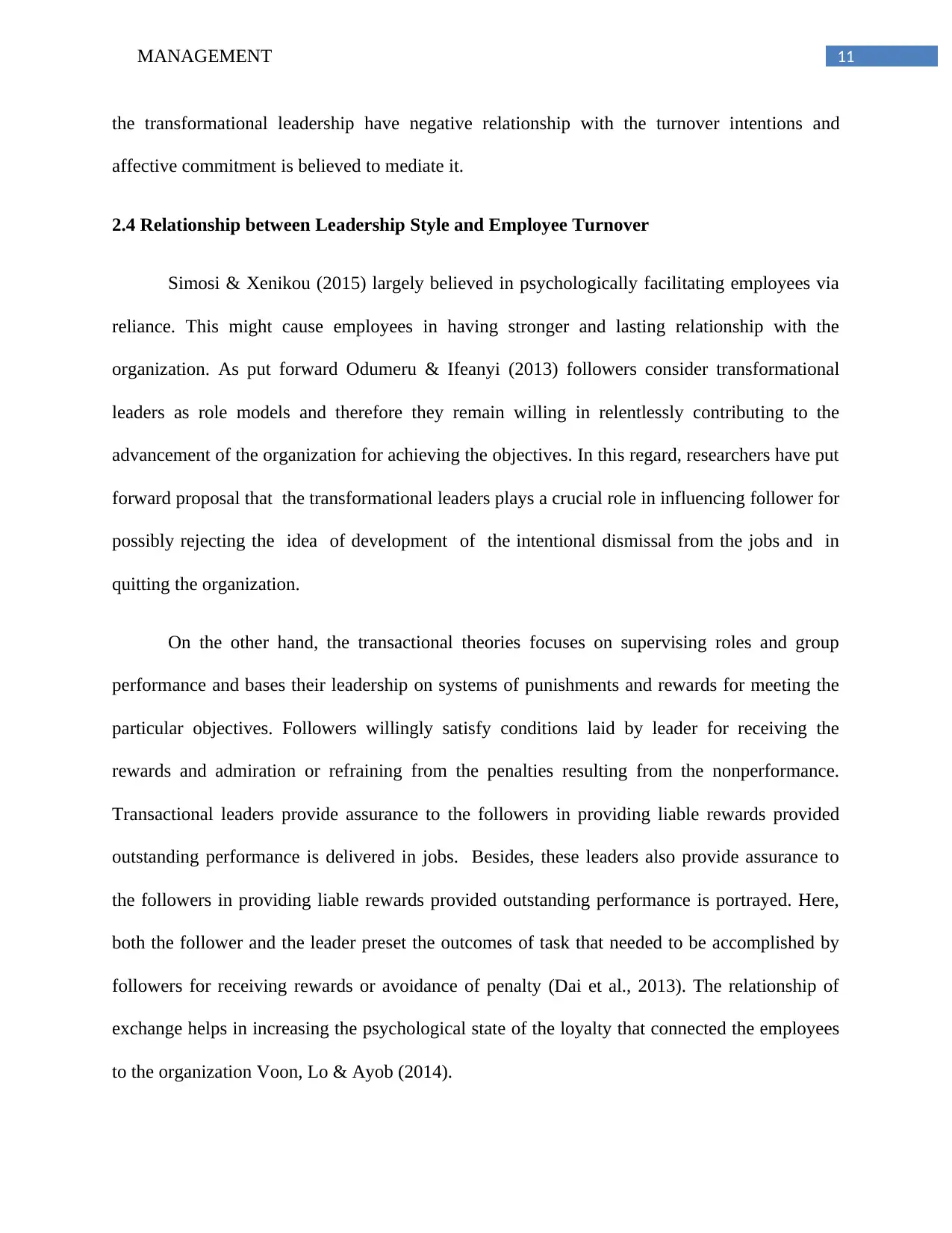
11MANAGEMENT
the transformational leadership have negative relationship with the turnover intentions and
affective commitment is believed to mediate it.
2.4 Relationship between Leadership Style and Employee Turnover
Simosi & Xenikou (2015) largely believed in psychologically facilitating employees via
reliance. This might cause employees in having stronger and lasting relationship with the
organization. As put forward Odumeru & Ifeanyi (2013) followers consider transformational
leaders as role models and therefore they remain willing in relentlessly contributing to the
advancement of the organization for achieving the objectives. In this regard, researchers have put
forward proposal that the transformational leaders plays a crucial role in influencing follower for
possibly rejecting the idea of development of the intentional dismissal from the jobs and in
quitting the organization.
On the other hand, the transactional theories focuses on supervising roles and group
performance and bases their leadership on systems of punishments and rewards for meeting the
particular objectives. Followers willingly satisfy conditions laid by leader for receiving the
rewards and admiration or refraining from the penalties resulting from the nonperformance.
Transactional leaders provide assurance to the followers in providing liable rewards provided
outstanding performance is delivered in jobs. Besides, these leaders also provide assurance to
the followers in providing liable rewards provided outstanding performance is portrayed. Here,
both the follower and the leader preset the outcomes of task that needed to be accomplished by
followers for receiving rewards or avoidance of penalty (Dai et al., 2013). The relationship of
exchange helps in increasing the psychological state of the loyalty that connected the employees
to the organization Voon, Lo & Ayob (2014).
the transformational leadership have negative relationship with the turnover intentions and
affective commitment is believed to mediate it.
2.4 Relationship between Leadership Style and Employee Turnover
Simosi & Xenikou (2015) largely believed in psychologically facilitating employees via
reliance. This might cause employees in having stronger and lasting relationship with the
organization. As put forward Odumeru & Ifeanyi (2013) followers consider transformational
leaders as role models and therefore they remain willing in relentlessly contributing to the
advancement of the organization for achieving the objectives. In this regard, researchers have put
forward proposal that the transformational leaders plays a crucial role in influencing follower for
possibly rejecting the idea of development of the intentional dismissal from the jobs and in
quitting the organization.
On the other hand, the transactional theories focuses on supervising roles and group
performance and bases their leadership on systems of punishments and rewards for meeting the
particular objectives. Followers willingly satisfy conditions laid by leader for receiving the
rewards and admiration or refraining from the penalties resulting from the nonperformance.
Transactional leaders provide assurance to the followers in providing liable rewards provided
outstanding performance is delivered in jobs. Besides, these leaders also provide assurance to
the followers in providing liable rewards provided outstanding performance is portrayed. Here,
both the follower and the leader preset the outcomes of task that needed to be accomplished by
followers for receiving rewards or avoidance of penalty (Dai et al., 2013). The relationship of
exchange helps in increasing the psychological state of the loyalty that connected the employees
to the organization Voon, Lo & Ayob (2014).
⊘ This is a preview!⊘
Do you want full access?
Subscribe today to unlock all pages.

Trusted by 1+ million students worldwide
1 out of 19
Related Documents
Your All-in-One AI-Powered Toolkit for Academic Success.
+13062052269
info@desklib.com
Available 24*7 on WhatsApp / Email
![[object Object]](/_next/static/media/star-bottom.7253800d.svg)
Unlock your academic potential
Copyright © 2020–2025 A2Z Services. All Rights Reserved. Developed and managed by ZUCOL.





